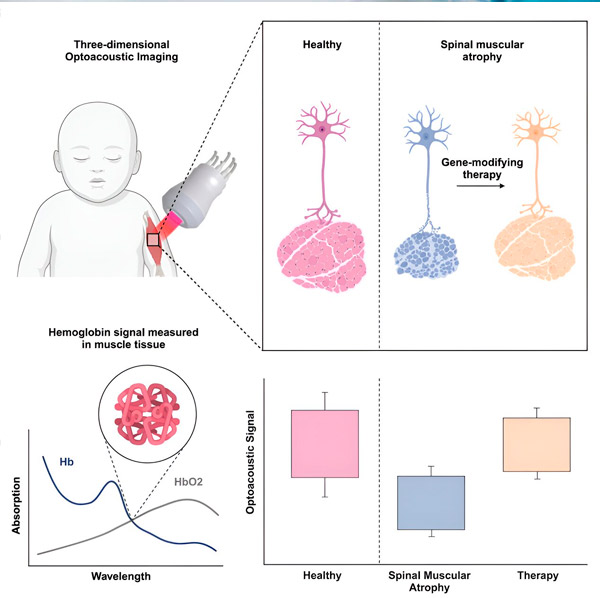
脊髓性肌萎缩症(SMA) 是一种严重的疾病,其基因突变会导致某些负责向肌肉传递信号的神经发生退化。这会导致肌肉萎缩,许多患者因这种罕见疾病而痛苦地死去。基因疗法近年来才逐渐普及。
现在,由埃尔朗根大学医院儿科和青少年医学系转化儿科工作组的 Emmanuel Nedoschill、Ferdinand Knieling 和 Adrian Regensburger 领导的团队开发了一种复杂的程序,与这些治疗方法结合使用时显示出令人鼓舞的结果:短激光脉冲产生声波,然后提供肌肉组织的图像。
他们在《Med》杂志上发表了一篇有关他们研究结果的论文。
“这种方法类似于早已存在的超声波扫描,”Nedoshiel 解释道。“只需几分钟,体外扫描就能提供体内肌肉状况的图像。”
这种光声成像方法的主要优势之一是,即使是幼儿通常也能轻松配合,因为它是一种非侵入性操作,无需吞咽或注射造影剂。这不仅简化了医疗团队的工作,也改善了患儿及其父母住院期间的条件。
这种情况通常会给患者带来极大的压力。这种疾病是由基因组中一种名为“SNM”的蛋白质的微小变化引起的,但这种蛋白质的缺失会导致某些负责向肌肉细胞传递信号的神经退化。受影响的肌肉会萎缩。对于普通人来说,了解这种疾病的后果以及不同的发展方式可能会非常困难。
一类是“行走型”,他们还能自己走几步。“久坐型”的情况则更糟。如果没有帮助,他们只能坐着,无法自己站起来。最糟糕的是“非久坐型”,他们甚至无法坐着。如果吞咽或呼吸所需的肌肉受到影响,这种疾病可能会致命。
幸运的是,大约每10,000名新生儿中只有1人携带SNM基因突变。然而,受影响人群的痛苦如此巨大,以至于现有治疗方法的任何改进都堪称重大突破,例如埃尔朗根大学医院儿科和青少年医学系正在研究的一种名为“光声成像”(OAI)的治疗方法。
这些疗法在几年前才开始应用,为治疗这种此前几乎无法治愈的疾病带来了重大突破。即使在最严重的病例,即所谓的“久坐不动”患者,也取得了显著的改善。
然而,到目前为止,追踪这一进展的唯一方法是进行可能持续数天的、极其艰苦的运动测试。这些测试的本质也可能损害其客观性。有些人可能比其他人付出更多努力,导致一些孩子的成绩比其他孩子更好。孩子们的情绪也可能每天都在变化,从而影响测试结果。
利用近红外光短激光脉冲进行OAI手术,可以显著提高这些观察的客观性。这些光脉冲会加热受影响的组织,然后发出声波,提供有关患者体内各种结构的重要信息。例如,组织由胶原蛋白组成,与肌肉或脂肪组织相比,胶原蛋白会反射不同的声波频谱。

资料来源:医学 (2024)。 DOI:10.1016/j.medj.2024.02.010
“在肌肉中,我们可以识别出红细胞中血红蛋白的光谱,它负责向身体输送氧气并清除二氧化碳,”内多希尔解释说。肌肉细胞越多,它们越活跃,它们完成工作所需的氧气就越多。
如果埃尔朗根大学医院的研究人员发现血红蛋白增多,他就知道这意味着肌肉质量显著提升。另一方面,如果肌肉萎缩并被结缔组织取代,3D图像可以显示病情进展,并最终导致胶原蛋白增多,从而记录肌肉质量的萎缩。
这为 Nedoshiel 这样的医生提供了一种像超声波扫描一样快速且易于使用的工具,并提供了肌肉和结缔组织如何移动的详细图像。
在埃尔兰根开展的一项利用血红蛋白追踪技术的研究表明,SMA患儿的肌肉组织明显少于健康对照组。然而,在接受挽救生命的基因治疗后,血红蛋白浓度有所升高,萎缩的肌肉开始再生,超声波信号也很快恢复到健康生物体的水平。
得益于埃尔兰根儿科和青少年医学系的研究,现在可以提供一种相对简单的工具来监测肌肉萎缩的进展和治疗的成功率。

